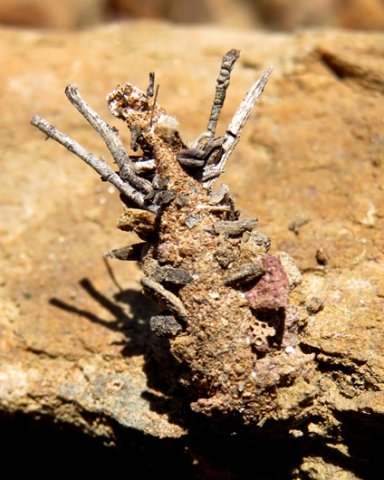Bagworm, masterpiece of efficiency

Author: Ivan Lätti
Photographer: Thabo Maphisa
The sandy structure in picture is a bagworm, or at least its self-made bag, home, clothing and camouflage, all-in-one. Bagworms or Psychidae are a family of butterflies and moths found on land globally, in many places where plants grow. The bag may be 1 cm to 15 cm long, depending on the species.
There are about 1350 species of bagworms on earth, each constructing its particular, recognisable bag or case. It is the caterpillar that constructs these cocoon-like bags, silken on the inside, the silk secreted from the caterpillars body. On the outside it is covered in the available environmental material like sand, soil, lichen, twigs or other plant debris. The bag blends with the environment as it is made of the same materials, providing some security against predators. The bagworm can move forward out of the bag to find food and retreat into its refuge when sensing danger.
Some bags are flat, many are narrowed at both ends, some are very strong. The bags are attached to rocks, trees or other suitably stable bases with the insects bodysilk for resting or metamorphosis during the pupa phase. The caterpillars build and eat leaves or lichen as if their lives depended upon it, which is true.
In some species the adult females are wingless moths, while others have only vestigial wings, legs and mouthparts. Some can even produce offspring without mating with the opposite sex, a weird phenomenon called parthenogenesis, increasing efficiency even further.
The newly hatched bagworm commences bag building immediately, adding new material to the front end of the bag continually, while eating useful bits among its building material and excreting waste through the bag opening at the back.
Bagworm eating happens mostly during the larval phase. The caterpillar can literally devour a host plant. Even trees may suffer. A bagworm species that lives on one particular plant species may wreak more visible havoc than those that sample plants widely.
When enough has been consumed, the once in a lifetime feast over, it stops abruptly and turns into a pupa, conveniently in the home comfort of its bag.
Turned butterfly or moth and ready to mate, only the adult male ever leaves its bag and flies off purposefully in search of a mate, never to return. He mates by thrusting his abdomen into the female’s bag and body. He has to do this soon, because of his underdeveloped mouth. He is sure to die shortly from lack of nutrition. This must not happen before he has found a mate.
The fertilised female dies, never leaving her bag and without laying her eggs. Job done, life lived, purpose fulfilled, eggs to be hatched after she’s gone, no longer her responsibility but the species remaining extant.
Bagworm predators are birds and some other insects. A female bagworm can be eaten by a bird, leaving her hard-shelled eggs undamaged in the bird’s digestive system, which contributes to egg dispersal and species spread. She would have died anyway after mating, the eggs normally hatching inside her carcass.
Both sexes live just long enough for performing their procreative functions in great economy of resource utilisation. In biological terms bagworms are exceedingly more efficient than people (Wikipedia).

